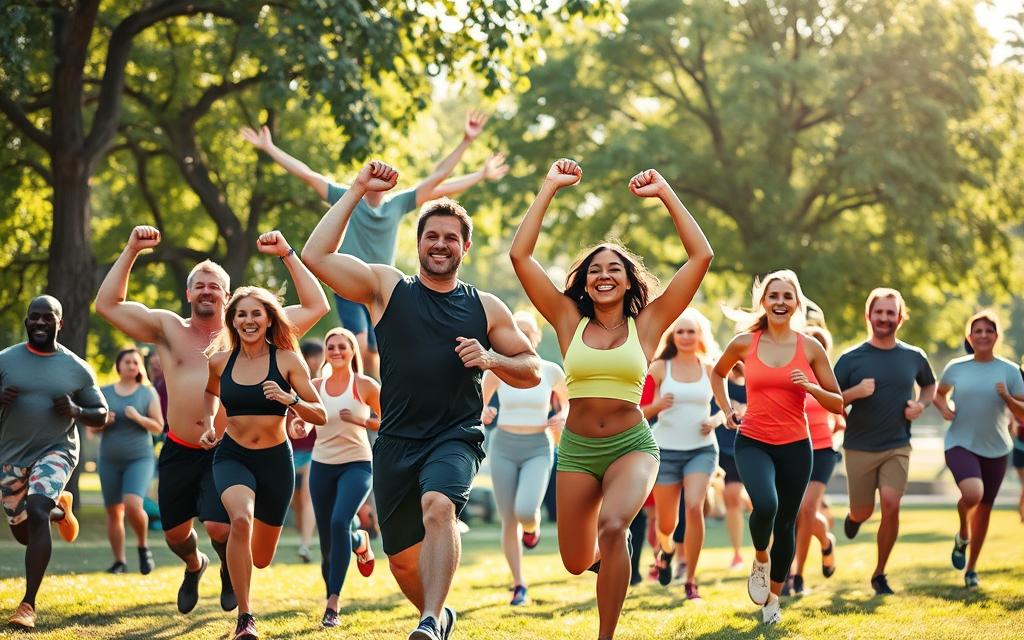Confidence is key to building our dreams and goals. It’s the inner voice that says, “You can do this,” even when things seem tough. I’ve faced self-doubt and low self-esteem, but I’ve learned how powerful self-belief can be. In this guide, we’ll look at proven ways to boost your self-confidence and reach your full potential.
Self-confidence is essential, not just a luxury. It’s what lets us take risks, reach our goals, and connect deeply with others. Without it, we might hold ourselves back, hesitate to try, or doubt ourselves too much. But, the good news is that we can grow our self-confidence, just like any skill.
Here, you’ll find many practical, science-backed tips to improve your self-confidence. We’ll cover how to build a positive self-image and use body language to your advantage. You’ll learn the science behind self-belief and get the tools to change your mindset. Get ready to start your journey of self-discovery and empowerment. The path to more confidence begins here.
Understanding the Foundation of Self-Confidence
Self-confidence, also known as self-efficacy, is key for doing well under stress. Research shows that 96% of C-level executives want more in tough situations. Self-esteem is how we see ourselves, often by comparing to others. It can change a lot and is affected by social media and lifestyle content.
The Psychology Behind Self-Belief
Self-confidence is about believing in our ability to do specific tasks. This confidence psychology is vital in our daily lives. It affects our motivation, problem-solving, and resilience.
How Confidence Impacts Daily Life
- A study found that students who sat up straight felt more confident in math. Those who slouched felt less capable.
- Research at Ohio State University showed that good posture made people believe they were qualified for a job. Slumped people felt less confident.
The Difference Between Self-Esteem and Confidence
Developing an equality mentality is important. It means seeing ourselves as equal to others. Self-confidence is a skill we can learn and improve over time.
The Science of Self-Belief Enhancement Techniques
Building self-confidence is complex, and science has found many ways to help. One key method is using the mind with self-affirmations and visualization.
Research shows that affirmations can really help. They can make people feel more confident and less stressed. But, how well they work depends on how you see yourself. If you don’t think much of yourself, you might feel worse at first. But if you already feel good about yourself, you’ll likely feel even better.
Visualization works in a similar way. It uses the brain’s reward centers to build confidence. Just like how muscles get stronger with exercise, confidence grows with mental practice.
- Affirmations have shown some effectiveness in improving self-esteem and resilience.
- Individuals who practice positive affirmations may experience increased self-confidence and self-worth, and reduced production of cortisol, a stress hormone.
- Engaging in self-affirmation tasks can reduce neural activity in regions associated with threat processing and stress reactivity, leading to lower stress levels.
- Studies have shown that positive self-affirmations can activate brain regions associated with positive emotion regulation and reward processing.
The science of self-belief techniques and confidence-building science shows us the power of our minds. By using affirmations and visualization, we can build a stronger sense of self. This unlocks our true potential.

Mastering Positive Self-Talk for Confidence Building
Controlling your inner dialogue is key to building strong self-confidence. Your mind listens to and programs itself based on your positive self-talk and affirmations. By using affirmations and watching your inner dialogue, you can change your mindset and reach your full potential.
Replacing Negative Thought Patterns
Studies show that switching from first-person to second-person self-talk (like “You’ve got this!” instead of “I’ve got this!”) can lower stress and boost performance under pressure. By swapping negative thoughts for positive, empowering ones, you can build a strong and confident mindset.
Creating Powerful Daily Affirmations
- Make affirmations that match your goals and dreams.
- Repeat your affirmations often, out loud or in your mind, to make them stick.
- Imagine yourself succeeding as you say your affirmations.
Monitoring Inner Dialogue
Pay attention to your inner dialogue all day. Spot negative self-talk and replace it with positive, empowering thoughts. This habit will help you grow more confident and self-assured, leading to more success and happiness.
Physical Appearance and Confidence Connection
The link between how we look and our confidence is complex and interesting. Research shows that our view of our appearance greatly affects our self-image and confidence.
Self-esteem and body image can change over time. This means the relationship between how we look and our confidence is not always the same. People who see a big change in their looks, like a visible difference, might feel less confident.
Looking at others can also affect us. A 2018 study found that feeling envious of others can lower our self-esteem. Constantly comparing ourselves to others can make us feel less confident.
But, being active can help boost our confidence. A 2016 study found that exercise can improve how we see our bodies and make us feel more confident. A 2015 study also showed that being kind to ourselves can help us feel more confident.
To build a positive self-image and appearance and confidence, we need to focus on our own strengths. It’s important to surround ourselves with supportive people and seek help when needed. Doing things that make us happy can also help improve our self-esteem and confidence.
The Power of Body Language in Building Confidence
How we carry ourselves can greatly affect our self-confidence. Harvard professor Amy Cuddy’s research shows that certain body postures can change our hormones. This can make us feel more powerful and confident.
High-Power Poses for Confidence
Using high-power body positions can make us feel more present and confident. Standing tall with shoulders back or sitting with legs outstretched can boost our self-assurance. These poses increase testosterone and lower cortisol, making us feel more powerful.
Non-Verbal Communication Skills
Non-verbal communication skills are also key in showing confidence. Keeping good eye contact, using confident hand gestures, and avoiding fidgeting can make us appear more assured. These actions help us look trustworthy.
Studies show that non-verbal cues often mean more than what we say. Mirroring and matching body language can help build rapport and connection. This can also boost our self-confidence.
Learning confident body language is a powerful way to increase self-belief. By understanding and using these techniques daily, we can tap into the power of body language. This can help us build our confidence and presence.
Exercise and Physical Activity’s Role in Self-Belief
Regular exercise and physical activity can greatly improve self-confidence and well-being. Studies show that fitness activities boost self-esteem, productivity, and mental health.
Exercise not only makes you look better but also improves your mood. It helps reduce depression and keeps your weight healthy. Just 30 minutes of exercise three times a week can make you feel more confident. As you get fitter, you’ll feel more confident and accomplished.

A recent study found that regular exercise, feeling fit, and having a positive body image boost self-esteem in adults. When people exercise more, they see their physical abilities and appearance in a better light. This boosts their confidence and self-esteem.
Adding regular exercise to your daily routine can greatly benefit your health and self-belief. It doesn’t matter if you work out alone, join a class, or connect with others online. The fitness benefits are powerful for building and keeping self-confidence.
Visualization Techniques for Enhanced Confidence
Visualization, or mental imagery, is a strong tool for building self-confidence. It works by imagining yourself succeeding in different scenarios. This practice makes the brain’s confidence pathways stronger with each use.
Many top athletes, like Michael Phelps, use visualization in their training. They say it’s key to improving their performance. This shows how effective it can be.
Creating Mental Success Images
Visualization means creating clear mental pictures of what you want to achieve. Research at the University of California found that students who used visualization before a test did better than those who didn’t. Seeing yourself succeed boosts your belief in yourself.
Using Imagery for Goal Achievement
A study by the American Psychological Association found that athletes who used visualization in their training felt more confident and performed better. Imagining how you’ll achieve your goals helps you stay focused and motivated. It also builds your confidence in reaching your goals.
Regular use of visualization strengthens your brain’s confidence pathways. Studies also show it can lower anxiety, leading to better performance. By using your mind, you can reach your full potential and believe in yourself more.
Building a Supportive Network for Confidence Growth
Having a strong network of friends, colleagues, and mentors is key for self-confidence. Being around positive people who give good feedback and encouragement boosts your confidence. On the other hand, negative folks can make you doubt yourself.
To build a supportive network, look for positive relationships with people who want you to succeed. They offer a safe place to share your thoughts and dreams without fear of being judged. Their support can make you feel more confident and help you face challenges with a positive attitude.
- Seek out individuals who share your values and interests.
- Join groups or communities aligned with your personal or professional goals.
- Engage in regular check-ins and conversations with your trusted network.
- Be open to receiving constructive feedback and be willing to provide the same to your network.
- Celebrate each other’s successes and milestones, as this can reinforce your sense of accomplishment.
Your social circle greatly affects your self-confidence. Surrounding yourself with a supportive network of positive relationships can help you reach your full potential. It starts a journey of confident self-growth.

Goal Setting and Achievement Strategies
Setting and achieving small, yet challenging goals is a great way to boost self-confidence. Start with goals that are just out of your reach but still possible. Then, make them harder as you get better. This way, you’ll keep growing and feel more confident with each success.
Breaking Down Large Goals
Big goals can feel too much to handle. But, breaking them down into smaller steps makes them easier. Create a plan with clear, doable tasks. Focus on one at a time to keep moving forward and feel like you’re making progress.
Celebrating Small Victories
- Celebrating small achievements is key to building self-confidence.
- When you reach a goal, no matter how small, take time to celebrate your hard work.
- This positive feedback boosts your self-belief and keeps you motivated to reach your goals.
Setting goals that match your values and strengths makes you more motivated and confident. Goals that align with your core values lead to fulfillment and a sense of achievement. This fuels your self-belief and helps you grow.
Remember, setting and achieving goals is a powerful way to build self-confidence. Enjoy the journey, celebrate your wins, and watch your self-belief grow.
Overcoming Fear and Self-Doubt
Fear and self-doubt can hold you back. But, with the right strategies, you can break free and reach your full potential. Let’s look at how to face fear and manage self-doubt to boost your confidence and success.
Self-doubt is common and often comes from uncertainty about your abilities or worth. It can show up as trouble accepting praise, needing constant reassurance, feeling unworthy, or feeling like you’re not good enough. To beat self-doubt, practice self-compassion, reflect on your past successes, and get support from people you trust.
Writing down your thoughts and questioning negative ones can help fight self-doubt. By looking at your beliefs and challenging them, you can change your self-talk and build a more positive image of yourself. Inspired by Judi Holler’s book “Fear Is My Homeboy,” facing discomfort and seeking growth can also build your strength and confidence.
- Recognize and challenge irrational fears: Fear can warp how we see things, like tinted glasses. By facing and correcting these distortions, you can regain your confidence and move forward clearly.
- Embrace uncertainty and take calculated risks: Stepping out of your comfort zone and facing the unknown can be scary. But, it’s where you grow and find true fulfillment. Celebrate your small wins and learn from your failures.
- Surround yourself with a supportive network: Being around people who uplift and support you can fight self-doubt. Look for mentors, join groups that support you, and build relationships that boost your confidence.
- Seek professional guidance: If fear and self-doubt are hard to shake, consider a life coach or therapist. They can offer tools and strategies to help you overcome these obstacles and build lasting confidence.
Beating fear and self-doubt is a journey. But, with the right mindset and a commitment to growth, you can unlock your potential and thrive. Remember, you are capable, worthy, and deserving of success. Face your fears, challenge your doubts, and watch your confidence grow.

Mindfulness and Meditation for Self-Belief
Looking to boost your self-confidence? Mindfulness and meditation are game-changers. They change how we see and live life, helping us believe in ourselves more. By letting go of negative thoughts, we can break free from beliefs that hold us back.
Daily Mindfulness Practices
Adding mindfulness to your daily life boosts confidence. Simple activities like focused breathing and body scans help you connect with your thoughts and feelings. This awareness lets you face and fight negative self-doubt.
Meditation Techniques for Confidence
- Loving-Kindness Meditation: This practice builds compassion, for yourself and others. It helps reduce self-criticism and boosts self-acceptance.
- Visualization Meditation: Imagining yourself achieving goals strengthens your belief in yourself. It motivates you to take action.
- Body Scan Meditation: Paying attention to your body’s sensations makes you feel more grounded and confident.
Studies show that regular meditation can change your brain. After just a month, it can reduce brain activity linked to negative thinking. A consistent mindfulness and meditation routine can change your mindset, unlocking self-belief.
Professional Development and Confidence Building
Investing in your career can really boost your confidence at work. Learning new things, improving your skills, and keeping up with trends makes you feel more capable. Getting a mentor, going to workshops, and taking on tough projects can help you feel more confident.
Learning new skills through professional development makes you feel accomplished. It helps you tackle work tasks better, making you believe in yourself more. This is what we call career confidence.
Also, getting involved in professional growth lets you see different ways of doing things. This can spark new ideas and give you the tools to solve problems better. So, you start to feel more confident in making decisions and solving problems.
- Getting advice from experienced people can really help you grow and feel more confident.
- Going to workshops or training can give you the latest skills, making you feel more competent.
- Trying new things or taking on more work can help you learn and boost your career confidence.

By taking on professional development, you start to see yourself as a lifelong learner. This mindset helps you believe in your ability to succeed in your career. It can lead to happier job experiences, moving up in your career, and personal growth.
The Role of Past Experiences in Shaping Confidence
Our past experiences, from childhood, shape our self-esteem and confidence. Trauma, big life changes, and our environment greatly affect our self-belief. By understanding these impacts, we can change negative events and build stronger confidence.
A study found that 82.7% of participants felt confident. But, 14.9% felt like a failure and 28.3% felt useless at times. It showed that positive experiences boost confidence, while negative ones can lower it. Support from family, friends, mentors, and colleagues also boosts confidence.
- Learning new skills through lifelong learning can boost confidence.
- Cultural and societal norms, like gender stereotypes, can affect confidence.
- Education gives us practical skills that increase confidence. Specializing in a field can make us more confident and credible.
- Learning keeps our minds sharp, improving critical thinking and analytical skills. These skills help build confidence.
- Learning for life makes us adaptable, flexible, resilient, and creative. These traits help us face challenges with confidence.
- Seeking new opportunities through learning opens up possibilities and boosts confidence.
Understanding how past experiences shape our confidence helps us take action. We can change negative experiences, find supportive environments, and keep learning. This approach helps us build a strong, resilient confidence that empowers us to achieve our goals.
Maintaining Long-Term Confidence Growth
Building lasting self-confidence is more than a quick fix. It takes creating habits that last and checking your progress often. By doing daily or weekly activities that boost your self-belief, you build a strong base for lasting confidence.
Creating Sustainable Habits
It’s important to make routines that help your confidence grow. Some effective strategies include:
- Journaling your accomplishments and successes to reinforce your abilities
- Practicing self-compassion through affirmations and mindful self-reflection
- Engaging in regular physical activity to enhance your sense of well-being
- Surrounding yourself with a supportive network that encourages your growth
Regular Self-Assessment Methods
Checking your confidence levels and progress often is key. By employing techniques like:
- Periodic self-evaluations to identify areas for improvement
- Celebrating small victories and acknowledging your achievements
- Seeking feedback from trusted sources to gain an objective perspective
- Adjusting your approach as needed to maintain your long-term confidence and sustainable self-improvement
Maintaining long-term confidence needs a whole and steady effort. By making lasting habits and checking your progress, your self-belief will keep growing and thriving.
Conclusion
Building self-confidence is a journey that never ends. It takes hard work and practice every day. By using self-belief techniques and strategies, you can improve how you see yourself. It’s not about being perfect, but about believing in yourself, even when things get tough.
Doing mental exercises, staying active, and having a supportive network helps a lot. It helps you feel more confident and ready to take on new challenges. Whether you’re starting a new job or training for a big event, the key is to keep going and believe in yourself.
This article has given you tools to start a journey of self-discovery. Every step you take shows how powerful self-confidence can be. It opens doors to new experiences and helps you grow both personally and professionally. Keep moving forward, celebrate your wins, and watch your confidence grow. It will lead you to a brighter, more successful future.
